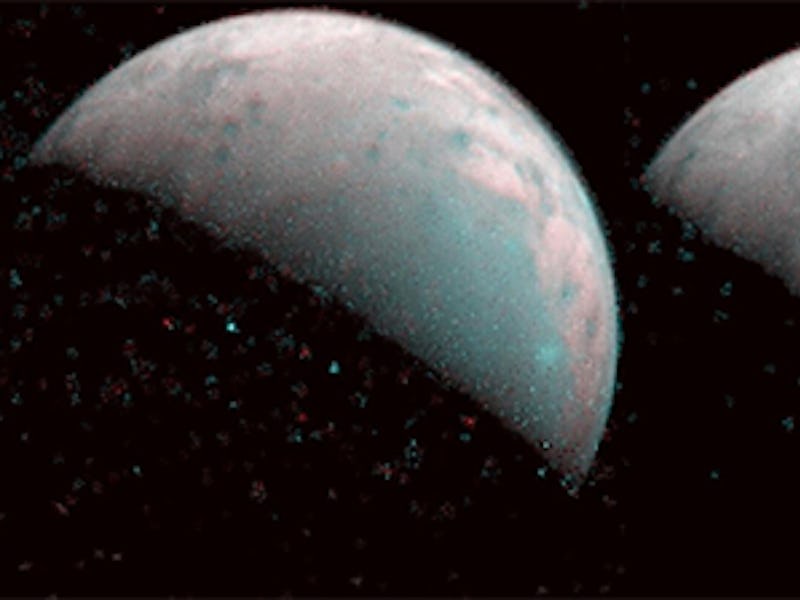Is Jupiter's moon Ganymede habitable? Scientists make a vital discovery

A 23-year-old mystery about the largest moon in our solar system has been solved.
In 1998, NASA’s Hubble Space Telescope captured Jupiter’s moon Ganymede in ultraviolet light. The images revealed a mysterious pattern of streaks painted across the Jovian moon — auroral bands similar to those observed on Earth.
But something in the data didn’t add up. Ganymede’s aurora indicated the presence of oxygen on the large moon, but scientists doubted that there would be that much oxygen in its atmosphere.
New information from Hubble's Cosmic Origins Spectrograph (COS) and archival images from the Space Telescope Imaging Spectrograph (STIS) from 1998 to 2010 has found a culprit behind this mysterious phenomenon: Ganymede releases water vapor from its icy surface. The recent findings are detailed in a study published Monday in the journal Nature Astronomy and provide scientists with precious insight on other icy moons in the Solar System that may host water and the possibility of life.
Ganymede is not only Jupiter's largest known moon — it is also the largest across the entire Solar System. It’s even larger than the planet Mercury.
Previous evidence suggested that Ganymede contains more water than all of the Earth’s oceans combined. But the moon’s body of water is likely buried hundreds of miles beneath its surface since its freezing temperatures would cause any water on its surface to be frozen solid.
WHAT’S NEW — As a follow-up to Hubble’s 1998 observations of Ganymede, the scientists behind the new study set out to measure the amount of atomic oxygen in Ganymede’s atmosphere:
Hubble captured the first ultraviolet images of Ganymede in 1998, revealing two distinct patters that indicated the moon’s auroral activity.
- The two patterns in the ultraviolet images indicated that Ganymede had molecular oxygen, which is made up of two oxygen atoms that are produced as charged particles erode the moon’s icy surface
- But the ultraviolet emissions didn’t match an atmosphere with that many oxygen molecules. Instead, they were more likely caused by atomic oxygen, made up of a single oxygen atom.
- In 2018, follow-up observations of Ganymede revealed that there was barely any atomic oxygen in its atmosphere
So, what could be causing the two distinct patterns of auroral features on Ganymede?
The scientists discovered that Ganymede’s temperatures vary throughout the day. Around noon, the temperature on the moon becomes relatively warm near the equator. This rise in temperature causes small amounts of water molecules to escape from the moon’s icy surface.
“The water vapor that we have now measured originates from ice sublimation caused by the thermal escape of H2O vapor from warm icy regions,” Lorenz Roth of the KTH Royal Institute of Technology in Stockholm, Sweden, and lead author of the new study, said in a statement.
Essentially, water vapor is escaping from Ganymede’s surface, resulting in the molecules detected in the moon’s atmosphere.
HERE’S THE BACKGROUND — Jupiter has a total of 79 known moons.
Ganymede represents one of several icy moons in the outer Solar System that provide scientists with the opportunity to study habitability in unlikely places.
Saturn’s moon Enceladus also has evidence of a subsurface ocean and plumes of water ice and vapor erupting from the moon’s south polar region, making it one of the most potentially habitable places of the Solar System. Europa, another large moon of Jupiter, also has a substantial subsurface ocean and smaller vapor plumes.
When searching for habitability outside of Earth, scientists often look for water as one of the main indicators that a celestial object could host some form of life.
Icy moons like Ganymede and Enceladus may not look like Earth, but they could be habitable in their own way.
WHAT’S NEXT — Ganymede is getting its very own mission soon.
The European Space Agency is launching the JUpiter ICy moons Explorer, which will begin the exploration of Ganymede, as well as two other moons Callisto, and Europa, in the year 2030. NASA’s Europa Clipper, scheduled to arrive in the system the same year, will have a few flybys of Ganymede as well.
"Our results can provide the JUICE instrument teams with valuable information that may be used to refine their observation plans to optimize the use of the spacecraft," Roth said.
Abstract: Ganymede’s atmosphere is produced by charged particle sputtering and sublimation of its icy surface. Previous far-ultraviolet observations of the OI 1356-˚A and OI 1304-˚A oxygen emissions were used to derive sputtered molecular oxygen (O2) as an atmospheric constituent but an expected sublimated water (H2O) component remained undetected. Here we present an analysis of highsensitivity spectra and spectral images acquired by the Hubble Space Telescope revealing H2O in Ganymede’s atmosphere. The relative intensity of the oxygen emissions requires contributions from dissociative excitation of water vapor, indicating that H2O is more abundant than O2 around the sub-solar point. Away from the sub-solar region, the emissions are consistent with a pure O2 atmosphere. Eclipse observations constrain atomic oxygen to be at least two orders of magnitude less abundant than these other species. The higher H2O/O2 ratio above the warmer trailing hemisphere compared to the colder leading hemisphere, the spatial concentration to the sub-solar region, and the estimated abundance of ∼1015 H2O/cm2 are consistent with sublimation of the icy surface as source.
This article was originally published on